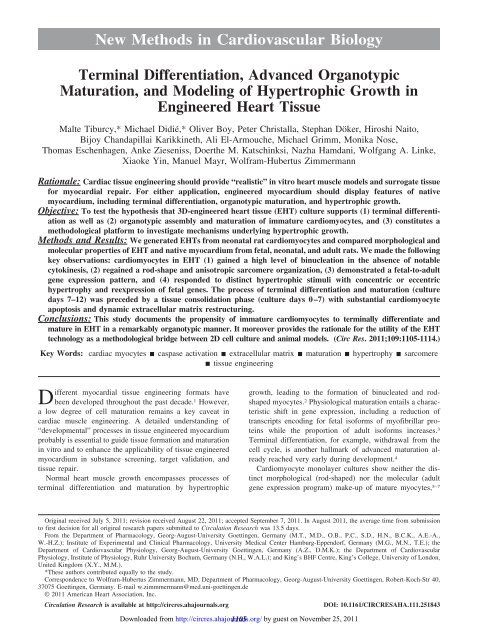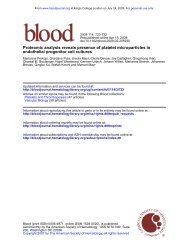Zimmermann Hamdani, Wolfgang A. Linke, Xiaoke Yin, Manuel ...
Zimmermann Hamdani, Wolfgang A. Linke, Xiaoke Yin, Manuel ...
Zimmermann Hamdani, Wolfgang A. Linke, Xiaoke Yin, Manuel ...
Create successful ePaper yourself
Turn your PDF publications into a flip-book with our unique Google optimized e-Paper software.
New Methods in Cardiovascular Biology<br />
Terminal Differentiation, Advanced Organotypic<br />
Maturation, and Modeling of Hypertrophic Growth in<br />
Engineered Heart Tissue<br />
Malte Tiburcy,* Michael Didié,* Oliver Boy, Peter Christalla, Stephan Döker, Hiroshi Naito,<br />
Bijoy Chandapillai Karikkineth, Ali El-Armouche, Michael Grimm, Monika Nose,<br />
Thomas Eschenhagen, Anke Zieseniss, Doerthe M. Katschinksi, Nazha <strong>Hamdani</strong>, <strong>Wolfgang</strong> A. <strong>Linke</strong>,<br />
<strong>Xiaoke</strong> <strong>Yin</strong>, <strong>Manuel</strong> Mayr, Wolfram-Hubertus <strong>Zimmermann</strong><br />
Rationale: Cardiac tissue engineering should provide “realistic” in vitro heart muscle models and surrogate tissue<br />
for myocardial repair. For either application, engineered myocardium should display features of native<br />
myocardium, including terminal differentiation, organotypic maturation, and hypertrophic growth.<br />
Objective: To test the hypothesis that 3D-engineered heart tissue (EHT) culture supports (1) terminal differentiation<br />
as well as (2) organotypic assembly and maturation of immature cardiomyocytes, and (3) constitutes a<br />
methodological platform to investigate mechanisms underlying hypertrophic growth.<br />
Methods and Results: We generated EHTs from neonatal rat cardiomyocytes and compared morphological and<br />
molecular properties of EHT and native myocardium from fetal, neonatal, and adult rats. We made the following<br />
key observations: cardiomyocytes in EHT (1) gained a high level of binucleation in the absence of notable<br />
cytokinesis, (2) regained a rod-shape and anisotropic sarcomere organization, (3) demonstrated a fetal-to-adult<br />
gene expression pattern, and (4) responded to distinct hypertrophic stimuli with concentric or eccentric<br />
hypertrophy and reexpression of fetal genes. The process of terminal differentiation and maturation (culture<br />
days 7–12) was preceded by a tissue consolidation phase (culture days 0–7) with substantial cardiomyocyte<br />
apoptosis and dynamic extracellular matrix restructuring.<br />
Conclusions: This study documents the propensity of immature cardiomyocytes to terminally differentiate and<br />
mature in EHT in a remarkably organotypic manner. It moreover provides the rationale for the utility of the EHT<br />
technology as a methodological bridge between 2D cell culture and animal models. (Circ Res. 2011;109:1105-1114.)<br />
Key Words: cardiac myocytes caspase activation extracellular matrix maturation hypertrophy sarcomere<br />
tissue engineering<br />
Different myocardial tissue engineering formats have<br />
been developed throughout the past decade. 1 However,<br />
a low degree of cell maturation remains a key caveat in<br />
cardiac muscle engineering. A detailed understanding of<br />
“developmental” processes in tissue engineered myocardium<br />
probably is essential to guide tissue formation and maturation<br />
in vitro and to enhance the applicability of tissue engineered<br />
myocardium in substance screening, target validation, and<br />
tissue repair.<br />
Normal heart muscle growth encompasses processes of<br />
terminal differentiation and maturation by hypertrophic<br />
growth, leading to the formation of binucleated and rodshaped<br />
myocytes. 2 Physiological maturation entails a characteristic<br />
shift in gene expression, including a reduction of<br />
transcripts encoding for fetal isoforms of myofibrillar proteins<br />
while the proportion of adult isoforms increases. 3<br />
Terminal differentiation, for example, withdrawal from the<br />
cell cycle, is another hallmark of advanced maturation already<br />
reached very early during development. 4<br />
Cardiomyocyte monolayer cultures show neither the distinct<br />
morphological (rod-shaped) nor the molecular (adult<br />
gene expression program) make-up of mature myocytes, 5–7<br />
Original received July 5, 2011; revision received August 22, 2011; accepted September 7, 2011. In August 2011, the average time from submission<br />
to first decision for all original research papers submitted to Circulation Research was 13.5 days.<br />
From the Department of Pharmacology, Georg-August-University Goettingen, Germany (M.T., M.D., O.B., P.C., S.D., H.N., B.C.K., A.E.-A.,<br />
W.-H.Z.); Institute of Experimental and Clinical Pharmacology, University Medical Center Hamburg-Eppendorf, Germany (M.G., M.N., T.E.); the<br />
Department of Cardiovascular Physiology, Georg-August-University Goettingen, Germany (A.Z., D.M.K.); the Department of Cardiovascular<br />
Physiology, Institute of Physiology, Ruhr University Bochum, Germany (N.H., W.A.L.); and King’s BHF Centre, King’s College, University of London,<br />
United Kingdom (X.Y., M.M.).<br />
*These authors contributed equally to the study.<br />
Correspondence to Wolfram-Hubertus <strong>Zimmermann</strong>, MD, Department of Pharmacology, Georg-August-University Goettingen, Robert-Koch-Str 40,<br />
37075 Goettingen, Germany. E-mail w.zimmmermann@med.uni-goettingen.de<br />
© 2011 American Heart Association, Inc.<br />
Circulation Research is available at http://circres.ahajournals.org<br />
DOI: 10.1161/CIRCRESAHA.111.251843<br />
Downloaded from http://circres.ahajournals.org/ 1105 by guest on November 25, 2011




